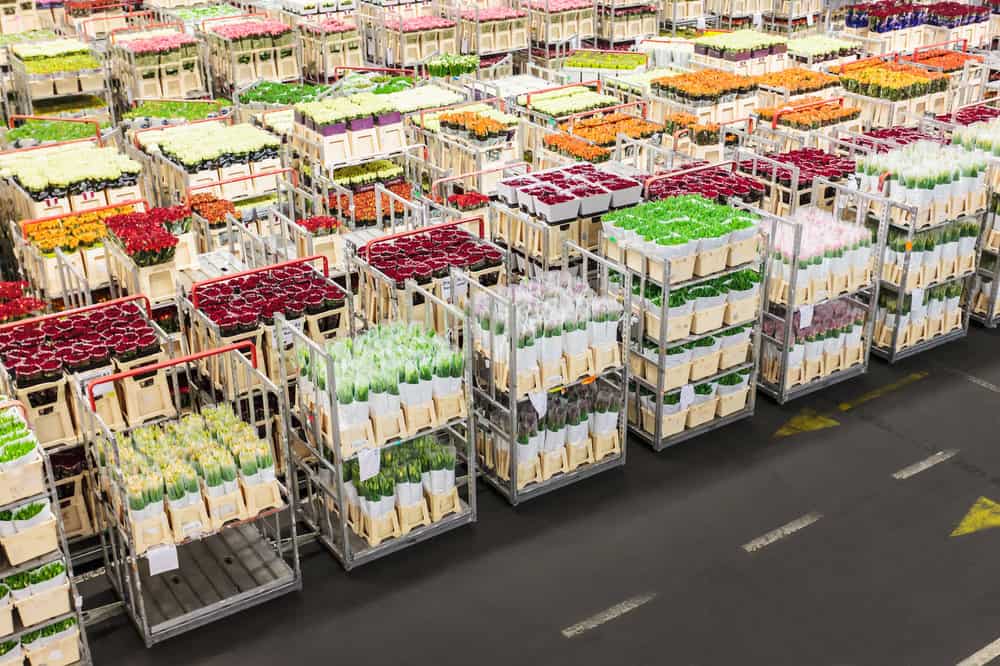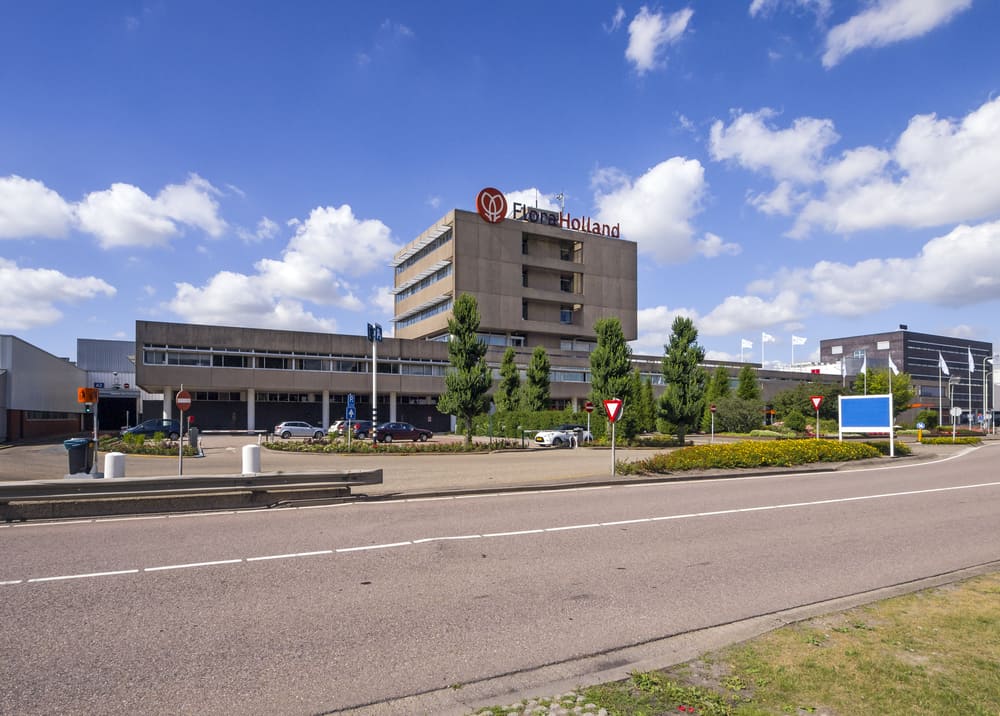
Imagine 2,000 trucks being loaded within a 4-hour window at three locations in the Chicago area for overnight delivery by 6 a.m. to cities as far away as Denver, Dallas, Atlanta, Philadelphia, Boston and New York City. You then begin to realize the scale of the world’s largest flower market in the Netherlands.
Every 24 hours, 30 million plants and flowers arrive in Holland from all over the world with most passing through three huge flower auctions, all within a 60 square mile area. The main Royal FloraHolland flower operations are at Aalsmeer, Naaldwijk and Rijnsburg, comprising 1,140 loading docks and covering a 14 million square feet area, equivalent to 243 footballs fields.
Around half the world’s flowers and plants pass through one of the 11 cooperatively-run regional flower auctions in Holland, with buyers and sellers bidding on trading floors just like a typical stock exchange in financial markets. Hence the term, “The Wall Street of Flowers”.

A Dutch Auction
From the moment the Dutch Auction starts at 6 a.m. and flowers are purchased, every order must be delivered to a loading dock within 2 ½ hours via any one of 280 battery powered scooter carts that haul the flower and plant-laden trollies. A “Dutch Auction” is unique in that prices start high at one euro, and then buyers drive down the price, which is displayed on one of 35 massive price clocks in auction trading rooms scattered throughout the three main locations.
Using a series of buttons and buying keypads, buyers frantically race to stop the clock at the price they want to pay, and then advise how many stems of plants they need to fill customer orders from the previous night. The challenge for buyers is that if they wait too long for their preferred price, they may miss out. That becomes problematic if they have already booked capacity on planes and trucks and have retail customers in Munich, Paris or London expecting fresh flowers the next morning. Buyers can also bid online from anywhere in the world and account for more than half of Royal FloraHolland’s 2,500 clients.
Most flowers head to Germany (29%), U.K. (14%) and France (13%), with 90% leaving same-day by road and 10% by air to Asian, U.S. and some Russian markets. (Siberia is served by a road-air combination).
The Egg
The process of moving flowers and plants from the auction room to the loading dock is logistical choreography at its most brilliant. The 280 scooter cart drivers work at a frantic pace from 6-11 a.m. daily. They receive all delivery navigation instructions verbally from a TomTom “egg” as it’s known locally: an egg-shaped navigation device on each driver’s belt. After voice recognition training during the initial hiring process, each driver speaks to a computer using a headset advising their location and via a barcode scanner communicates which one of 250,000 flower and plant trolleys they are connected to. This enables the TomTom navigation system to immediately send precise delivery routing for each trolley load of flowers and plants based on the buyer’s delivery dock location.
As an added safety measure, new hires wear a green vest and only haul full trolley loads (going to one destination), whereas more experienced orange-vest wearing scooter cart drivers deliver part loads to buyers on the more complex routes within the exchange. All the while truck drivers, who are paid an annual salary in Europe, are off-duty resting or asleep in their trucks waiting for their load to be ready, so as to maximize their 9-hour drive-time daily limit. In Europe, drivers can drive up to 10 hours per day twice per week. But they are limited to a 45-hour weekly total, have a 13-hour clock rule and must take 11 hours off every 24 hours.
(For a look at the floor and how it operates, please see this.)
Under Threat from the Internet
According to its just-released annual report, Royal FloraHolland’s 2017 annual turnover increased 1.2% to EUR4.7b 9US$5.7b0 based on sales of 11.7 billion units, which declined 1.8% from 2016. The decline in flower and plants unit sales is due to the rise in exports from Kenya, Columbia, Ecuador and Ethiopia, all close to the equator where growers have natural light all year round, reducing the need for artificial illumination. This is why trade typically moves south to north to the major U.S. and European markets from South America and Africa, respectively.
According to the 2016 Rabobank World Floriculture Report, the Netherlands is no longer the largest global exporter of cut flowers with 43% market share, with the four equator-based countries now making up 44% of exports. Their success is remarkable considering they have little domestic demand for their product, have limited air freight capacity, are exposed to volatile exchange rates, high transportation costs and an ever-changing geopolitical environment.
Royal FloraHolland began operation as a grower-owned cooperative more than 125 years ago (companies must be in business for 100 years to use the term royal) by dragging wooden boats on canals to showcase their flowers to prospective buyers. Today, they are being disrupted by the internet. As part of their digital strategy to become the world’s leading digital floriculture marketplace, Royal FloraHolland launched a digital supply platform called Floriday to integrate multiple third-party vendor platforms used by growers and members. In 2017 they also assumed majority control of FloraXchange, a large digital trading platform to strengthen their global competitiveness.
The bulk of their competition comes from mass-market retailers including Wal-Mart, Tesco and Aldi, who rather than trade on the volatility of flower spot prices via the auctions in Holland instead lock in growers to long-term fixed price contacts. In 2017, the company observed a shift from regular auction sales to direct sales between their growers and clients. Auction sales represented 44% of turnover while direct sales increased 6 percentage points to 56% of total revenues.
Kenya’s Blockchain Powered Supply Chain
Guided by Royal FloraHolland’s former CEO Lucas Vos who joined the company from Maersk in 2014, the company began a project involving Kenyan rose growers, IBM, Maersk and the Dutch government to improve efficiencies in the cut flower business and create the industry’s most highly developed supply chain. Today, Kenya has the largest international air cargo hub in Africa and has become the leading producer of roses for the European market, exporting 67% of tonnage to The Netherlands. In the process they have more than doubled Kenya’s global market share from 5% to 11% in the last decade.
In one study, IBM and Maersk followed a refrigerated shipping container filled with roses from Kenya to The Netherlands. They found that almost 30 people and organizations were involved in processing the container on its 34-day journey, resulting in 200 different communications and interactions between supply chain participants, resulting in 80 well-defined bottlenecks in the supply chain. Considering paperwork and established export/import processes are so vital to global trade, they are fast becoming one of its biggest impediments.
The solution was to create an electronic shipping platform by digitizing all documents using blockchain technology, with the aim of increasing transparency and security among all trading partners, reducing fraud and errors, and most importantly, decreasing time product is spent in transit. To compete in global markets, Kenyan growers put roses to sleep at zero degrees centigrade and keep them dormant for up to 3 weeks during the shipment to The Netherlands. This makes blockchain a vital component in speeding up the maritime supply chain and maintaining the competitiveness of South American and African exporters in the global cut flower market.
Notwithstanding the costs of keeping flowers cool, local growers in Holland will also delay shipping flowers to market by putting them to sleep so they can take advantage of favorable spot prices. In the flower spot market, prices are highest when weather is coldest and prices lowest when it’s hottest. The only exceptions are major seasonal events such as Mother’s Day, major religious events and certain public holidays when demand and prices are always high.
According to a global trade study by the World Economic Forum, the benefits of blockchain, an electronic ledger system that automatically verifies communications and customs border administration by replacing EDI and paper-based systems, can realize an additional US$1 trillion in global trade. According to IBM, Maersk already has entered close to 20% of its global containerized volume on to ledgers built on IBM’s Hyperledger blockchain platform, providing growers, shipping lines, freight forwarders, port and terminal operators, shippers and customs authorities access to the blockchain platform via a dashboard.
Tradition Meets Disruption
Flowers remain a luxury item. Even though it’s still a European tradition to buy flowers at the end of the work week–so the kitchen table has flowers over the weekend–flowers have become a cultural symbol of positivity: they make us feel good, especially roses. Of the 12 billion items sold at Royal FloraHolland in 2017, roses were the dominant cut flower with 3.3 billion (28%) involving over 1,000 different rose types (species, length and color) exported globally.
As the traditional Dutch Auction clock is challenged by online buyers and mass-market farm to shop retailers, another trend is emerging. Millennials are buying more and more plants and flowers, and they’re doing it in a way they are most familiar with: the click of a mouse.
While Royal FloraHolland’s CEO Steven van Schilfgaarde “remains committed to reinforcing the clock and its power”, it’s clear that digital platforms and blockchain technologies will enable more streamlined farm-to-ship supply chains in the future.
Online floriculture sales driven by millennials are expected to jump by 500% in the next 10 years according to one Rabobank study. A highly efficient high-speed supply chain using blockchain technology supported by reliable IT systems and data analytics will bring about more change in the next ten years than the traditional flower growers have seen in the last 125 years.











Derek Kirby
Amazing operation. Never really thought about how fresh flowers make it from the cut to the customer.